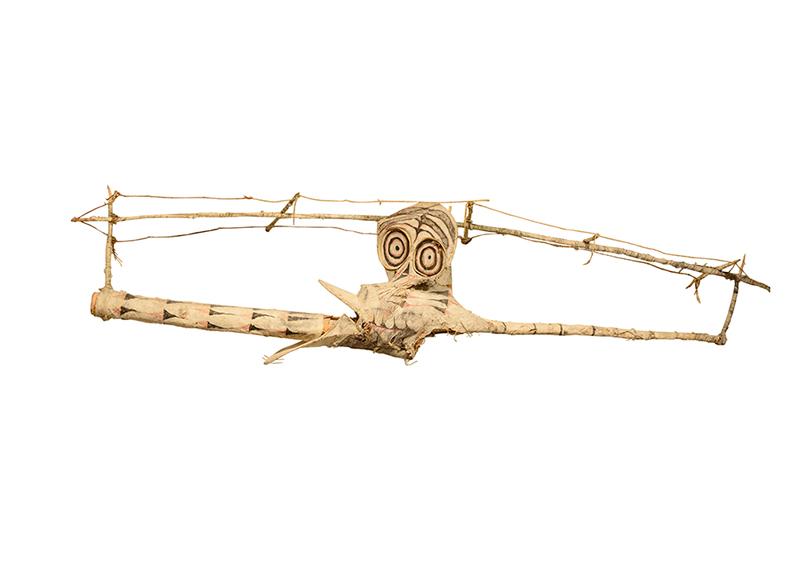Home
>
Works
>
Trumpet mask
>
Advanced Search
Folk, Indigenous, and Global
Other

Trumpet mask

Trumpet mask
Vernacular name:Vurbracha
Vernacular name:Vungvung
Vernacular name:Vungbungka
Maker: Baining people
Date: 1976-1977 ca.
Place Made:Gazelle Peninsula, East New Britain, Papua New Guinea, Asia
Serial No: none
Signednone
Markingsnone
Description3 sections: central helmet mask, body tube, and suspended frame.
Central mask: frame constructed from a pliable material, most likely wicker or qoarinka-wood, which is bent and manipulated to form a flat face and a protruding, open beak; entire structure covered with a thin, paper-like bark; diamond patterns and concentric circle design (eyes) painted in red and black pigments;
Body tube: bamboo tube core wrapped in same bark material as mask; one end inserted into the open mouth of the mask, extending outward, painted with a diamond pattern; long protrusion at the back end of the mask, either a long stick, cane, or wicker, attached with same wrapping material, painted with black bands;
Suspended frame: made of shorter sticks or lengths of cane attached to the body and mask, and one long, thin stick or piece of cane that runs along the entire length, with wound lengths of rattan, and wrapped with the bark material.
This mask isn't considered an instrument, although its wearer can vocalize through the bamboo tube (speaking trumpet or blowhorn). Its indigenous name is vurbracha, also known as the cob-web mask, and it is only one of numerous different masks associated with Baining dances. This particular mask was used in a Night-time, or Fire dance, which celebrates the male activity of the hunt.
Central mask: frame constructed from a pliable material, most likely wicker or qoarinka-wood, which is bent and manipulated to form a flat face and a protruding, open beak; entire structure covered with a thin, paper-like bark; diamond patterns and concentric circle design (eyes) painted in red and black pigments;
Body tube: bamboo tube core wrapped in same bark material as mask; one end inserted into the open mouth of the mask, extending outward, painted with a diamond pattern; long protrusion at the back end of the mask, either a long stick, cane, or wicker, attached with same wrapping material, painted with black bands;
Suspended frame: made of shorter sticks or lengths of cane attached to the body and mask, and one long, thin stick or piece of cane that runs along the entire length, with wound lengths of rattan, and wrapped with the bark material.
This mask isn't considered an instrument, although its wearer can vocalize through the bamboo tube (speaking trumpet or blowhorn). Its indigenous name is vurbracha, also known as the cob-web mask, and it is only one of numerous different masks associated with Baining dances. This particular mask was used in a Night-time, or Fire dance, which celebrates the male activity of the hunt.
DimensionsLength: 335 cm
Height at mask: 58 cm
Height at mask: 58 cm
ProvenancePurchased from H. M. Lissauer, Melbourne, Australia, in 1977.
Credit Line: Board of Trustees, 1977
On view
Object number: 02323
